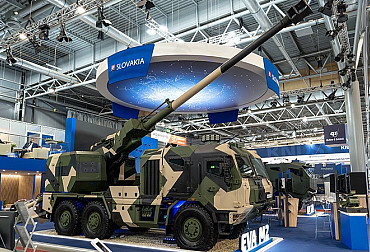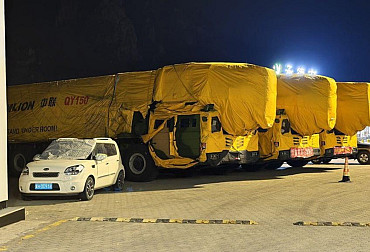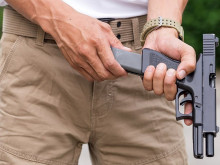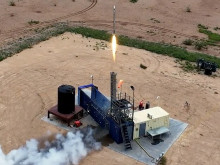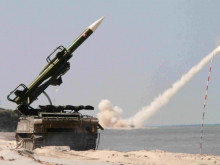Gen. Karel Řehka: KVAČR 2035 should not be perceived as a mere list of purchases of modern technology and equipment
The security situation in Ukraine and Israel, the recently approved Concept for the Construction of the Army of the Czech Republic 2035 (KVAČR 2035) or the planned acquisition of armoured vehicles for the engineer army - these were the key topics for the first meeting of the Defence Committee of the Chamber of Deputies of the Parliament of the Czech Republic, which took place yesterday on the parliamentary floor. In addition to Defence Minister Jana Černochová and the Chief of the General Staff of the Czech Army, Lieutenant General Karel Řehka, the meeting was also attended by the Chief of the Military Office of the President of the Republic, Major General Radek Hasala, the First Deputy Chief of the General Staff of the Czech Army, Lieutenant General Miroslav Hlaváč, the Director of Military Intelligence, Lieutenant General Jan Beroun, and other guests.
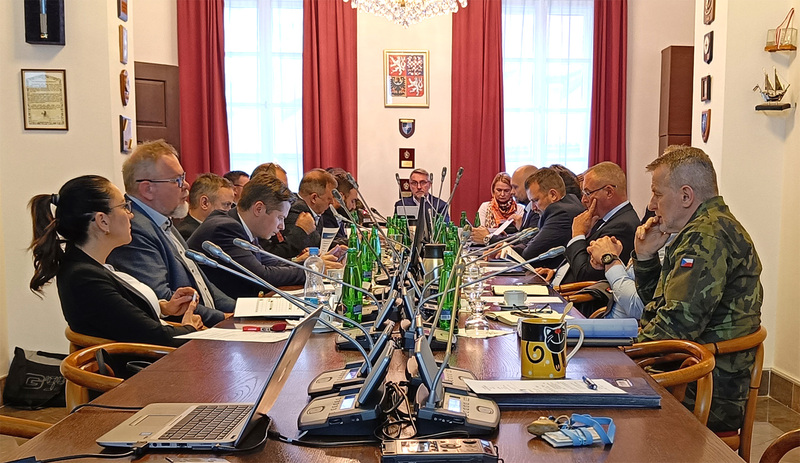
The Committee spent more than an hour on developments in Ukraine and Israel. This is a regular part of the meeting, which takes place in closed session, when Members are briefed on developments in both areas. The Committee also discussed the participation of the Czech Armed Forces in military exercises outside the Czech Republic and the participation of the armed forces of other states in military exercises on Czech territory in 2024. In total, there will be 168 exercises of our forces outside the Czech Republic and 58 exercises of other states on Czech territory. The total amount for these exercises will reach CZK 154 million. On this point, Defence Minister Jana Černochová said that the priority objective of exercises with foreign partners this year is to verify and increase the level of readiness of the Czech Armed Forces in defence in cooperation with other allies. "Another objective is to prepare for the joint participation of troops in operations and standby forces of international organisations," the minister said. In this context, the Chief of the General Staff recalled the largest NATO exercise since the Cold War, Steadfast Defender 2024, which started this week and in which 90,000 troops are participating. He also highlighted the overall change in approach to plans for joint exercises. He said the Czech Army also wants to follow a similar approach in its exercises with foreign participation.
The MPs then returned to the approved Concept for the Construction of the Army of the Czech Republic 2035, which they had discussed earlier (20 November 2023) at their retreat in Vyškov. The final version of the concept, after approval by the government, was received by the MPs after 21 December 2023. The minister said that the new concept sets out a clear vision for the development of the capabilities of the army as a whole. "It emphasises the need for strategic planning so that the resources proposed for national defence are not spent inefficiently. The concept also fulfils the tasks set out in the Defence Strategy of the Czech Republic 2023," said Jana Černochová, according to whom the document rationally and sensibly balances the need to prepare for a high-intensity conflict, takes into account the huge internal debt of the army from previous years and provides for an increase in defence spending and rapid progress in technology. "At the same time, the concept pays significant attention to our most precious resource, that is our people, our soldiers," the defence minister said.
General Řehka then emphasized that the KVAČR 2035 responds to the new realities of conflict. "This is a large-scale, high-intensity armed conflict with a technologically advanced adversary that has nuclear weapons," said Lt. Gen. Řehka, referring to the adopted defence strategy. At the same time, he pointed out that KVAČR 2035 is not to be seen as a mere list of purchases of modern equipment. "The concept is not an all-encompassing book on the army. It gives us a basic framework of where to go and develop. It is being worked out in detail into a number of other subordinate lower-order concepts, which then go into greater detail," the general said, adding: "KVAČR 2035 addresses first and foremost the strategic baseline, the strategic vision. It addresses where the Army is going, it addresses the strategic goals it wants to achieve and the general process of how it wants to achieve that, how it will manage the resources it is allocated."
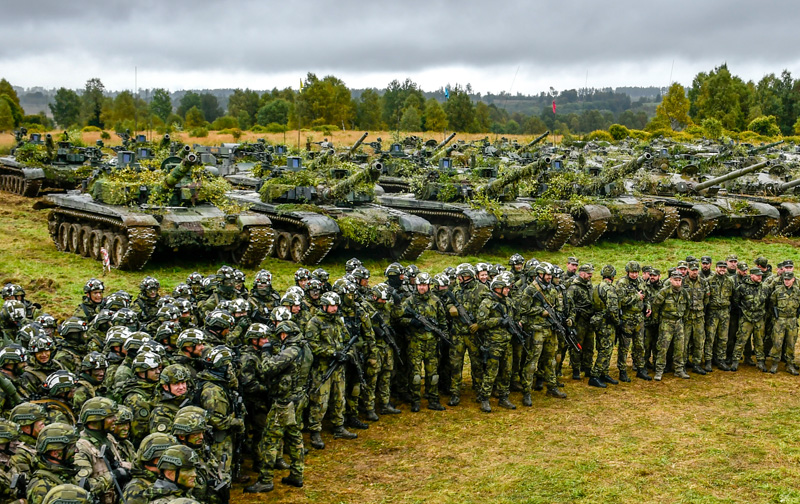
In the ensuing debate, the MPs addressed not only the postponement of some of the Army's purchases under the new concept, such as the time delay in acquiring self-propelled mortars, light assault vehicles, and C-RAM (Counter Rocket, Artillery and Mortar) capabilities. However, MEPs also discussed a change in the content of the concept. Questions were also directed to the analysis of the situation on the Ukrainian battlefield. The Chief of General Staff, Lt. Gen. Řehka said in response that one of the goals of the KVAČR 2035 was to link it to the Alliance's defence planning cycle. "The defence planning cycle in the Alliance is a four-year cycle. It starts with a policy directive, then minimum requirements are identified, build-up targets are developed, and these are assigned to individual countries. Then it is implemented and evaluated," General Řehka pointed out. Harmonisation with this planning system is one of the goals of the new concept, he said. At the same time, General ehka reminded that the army regularly analyses the situation in Ukraine.
Regarding the purchase of military equipment, General Řehka stated that even 2% of GDP for defence is not enough to immediately cover all the needs and debts of the past and to meet the objectives of building capabilities. "If we manage to save or release funds somewhere, we count on moving purchases over time. Of the so-called under-the-radar projects, self-propelled mortars are my number one priority, as is the light assault vehicle," the chief of staff said.
The Army is then more reticent about buying the C-RAM system, pushing the purchase back because the need was defined by previous experience of static object protection in missions in Afghanistan. General Řehka subsequently commented on the new concept that although it envisages an adversary with nuclear weapons, it does not mean their use. "An adversary equipped with nuclear weapons does not mean nuclear war. The strategy tells us that Russia is currently the direct and greatest threat to the Czech Republic. But I stress that the preparation is all about avoiding it, about having an effective deterrent, and that is how the alliance plans are built," the Chief of the General Staff explained to MPs.
In a subsequent debate with the deputy chairman of the committee Pavel Ruzicka, regarding the amount of ammunition the Army has today and is planned to have according to the concept (ammunition for 30 days) and also the amount of needs the army has to catch up, General Řehka said that the army is looking for ways and possibilities to be efficient in modernisation and to obtain as much modern weaponry as possible. "We need light assault vehicles, but we also need other things. It's not just about vehicles, it's also about anti-tank weapons and some of the heavier weapons that we need. As far as rocket launchers are concerned, give us three per cent of GDP and we will have rocket launchers. With two per cent, I am not able to fill the gaps that we lack from the past," the Chief of General Staff said. General Hlaváč then concluded the discussion by saying that the soldiers are building the capabilities of the army that are described in the concept. "It is important to have ready the forces, means and capabilities of the army allocated to the collective defence of the Alliance, and at the same time it is important to have a ready army that will provide tasks here on the territory of the Czech Republic and will provide its defence," General Hlaváč said.
At the request of the Minister of Defence, the committee then discussed the acquisition of armoured vehicles for the engineer army. Jana Černochová said that the forthcoming tender for armoured vehicles for the engineer army is currently in the so-called pre-acquisition phase, which in other words means that nothing has been decided at the moment. "Colleagues from the Ministry of Defence and the army are gathering all the necessary information and documents for the following decision," the minister said, adding that the start of the preparation of the project called "universal wheeled platform for the engineer army" dates back to 2018, when a market analysis was subsequently commissioned, in the framework of which several manufacturers, including Czech companies, were assessed as the most suitable and, above all, meeting the requirements of the Czech Army. Bushmaster armoured vehicles were then identified as the most suitable. "The requirements concerning, among other things, weight, use within the allied armed forces or combat deployment in operations were met. It is by meeting the latter two criteria, i.e. introduction and combat experience, that the army wants to avoid the often protracted difficulties associated with the development and subsequent introduction of new vehicles," said Cernochová on the subject. The market analysis was followed by a feasibility study in 2021, and here too the Bushmaster vehicle was identified as the only one that met the Army's required features and parameters. According to the minister, this acquisition was not completed under the previous government due to a lack of funding. Following the increase in the defence budget in the current parliamentary term, it was then decided to proceed with the tender. The market survey is now being updated and is being prepared by the state enterprise VOP CZ. "After the market research update is completed, a decision will be made on the most suitable and effective way of acquisition, both in terms of the required criteria and needs of the Czech Army, and in terms of price and the level of involvement of the Czech defence industry. The final decision on the procurement method should be made this year," the Minister added regarding the acquisition of the universal engineer platform.
In the ensuing discussion, MPs pointed out that there are three manufacturers of four types of these vehicles in the Czech Republic. The Chief of the Engineer Army, Colonel František Richter, assured the MPs present that the Czech defence industry will have its place in the update of this tender and also stated that the new armoured vehicle for the Engineer Army should meet several technical criteria. Firstly, the use of the vehicle itself, where deployment in urban areas must be taken into account. Secondly, it is about the engineer equipment, namely the clamping device, which the engineers have used extensively in previous missions, and the so-called roller. The possibility of transport by C-130 Hercules aircraft, the weight of the vehicle up to 20 tonnes and space for a crew of nine also play a role in the acquisition of a new engineer vehicle.
At the end of their meeting, the deputies heard information about the cancellation of the contract for the modernisation of 10 W-3A Sokol helicopters from the Polish manufacturer PZL-Świdnik, which the army uses to provide air rescue services. The reason for cancelling the contract was an increase in the original total price from CZK 250 million to CZK 850 million. The operation will be ensured by the existing service contract with the manufacturer until 2028.
In connection with the recently approved Concept for the Construction of the Army of the Czech Republic 2035, we asked the MPs the following questions:
1. In your opinion, is the material of the Concept of the Construction of the Army of the Czech Republic 2035 in any way different from previous conceptual materials?
2. In your opinion, does the KVAČR 2035 reflect the needs of an all-military army?
Lubomír Metnar (ANO), Chairman of the Committee
1. It is different, it is more general, less telling and lacks a clear progression for the future. The KVAČR 2035 was approved without a deeper analysis of the war in Ukraine and other security conflicts in the world, just as it was approved without the prior approval of the more general document, the long-term defence outlook, on which it was supposed to be based. Compared to the KVAČR 2030, apart from the acquisition of the F-35, no new modernization projects, such as missile launchers or air defense expansion, were defined. Despite the significant and leapfrog budget increase compared to the KVAČR 2030, there was insufficient justification for postponing the implementation of projects such as tanks, light attack vehicles or mortars. Apart from those mentioned, no major projects will be implemented in the next 3 years, at least not that we know of. It is questionable whether this is the impact of poor acquisition management or high advances, e.g. in 2024 almost 16 billion goes to the F-35 project.
2. The KVAČR 2035 does not specifically address the problem of insufficient coverage of the territory of the Czech Republic with ground-based air defence assets, or at least there is no mention of whether the Czech Republic will join the German air defence project called the European Sky Shield Initiative (ESSI).
In view of the current security situation, we see disappointing results in recruitment. In 2022, there was a net addition of only 219 professional soldiers. We all know the plans in 2030, 30 000 professional soldiers, when the attrition rate is currently very high. Our army has the second highest average age and freezing pay for next year, after a leap in the budget, is another nonsensical move by the MoD. Similarly for the active reserves, where the plan is for 10,000 active reserves by 2030. Also, the ratio of mandated expenditure in the total approved budget will fall from 19% to 14% in 2024.
Also not adequately addressed in the KVAČR 2035, as the defence strategy document shows, is the preparation of our military to fight a protracted, high-intensity defensive war with a technologically advanced adversary. Thus, in the KVAČR 2035, the development of a warfighting army, and the associated steps, are not adequately addressed.
Josef Flek (STAN), Vice-Chairman of the Committee
What I particularly like about the new KVAČR 2035 is that it places more emphasis on cooperation within NATO. The drafting of this new strategy was, of course, also based on the information obtained as a result of the war in Ukraine. The strengths and weaknesses of the army have been assessed. We are making a greater appeal for rapid deployment capability. It is important for us to have full combat capability and to be able to wage war against advanced enemies, which, unfortunately, are rather increasing.
Jan Hofmann (ODS), Vice-Chairman of the Committee
The concept of the KVAČR was presented to the committee at a retreat in Bučovice in November last year and on 30th January this year we, as a committee, were presented with the final version. The current version has been expanded to include points related to the all-weather army, expanding the possible activities of the army and intelligence officers, and also updating the needs for the acquisition of important equipment over time, so that with the approved defence spending within 2% of GDP, this modernisation is financeable. This is also in the light of the experience of the recent conflict in Ukraine and with a clear definition of the potential adversary.
Pavel Růžička (ANO), Vice-Chairman of the Committee
1. I would like to mention at the outset that General Řehka says that in 4 years Russia may invade NATO countries or the Czech Republic. I, having looked into the KVAČR, signed an acquisition to buy the F-35, which we should have in 2035 (it could also be in 2040), so in those four years, as the General says, these aircraft will not help us much. Key projects have been pushed back by the military. The tracked BVP is pushed back by about five years, the battle tank by two years, the fire control system by four years, the self-propelled mortars by ten years, the floating and transport bridges by four years, the Pandur upgrade by another year, the light assault vehicle by 11 years, and the C RAM, or air defence capability, by a whopping eight years. So I'm quite interested to know how the general is preparing for this war with Russia then. We do not have a fire control system, we will not have tanks, we will not have BVP, we will not have air defence for the Czech Republic. I can say that we would do it completely backwards. First of all, we would start working on having a heavy brigade, precisely processed, so that we have air defence of the Czech Republic, and then we would start wondering whether we should buy some supersonic aircraft, because there is time until 2035, and the Gripen will probably do the same quality of service.
2. I am still missing some experience from Ukraine. No one has told us what the war in Ukraine has said or what lessons the Czech Republic has learned from it. We here on the Committee keep hearing that we are gaining a lot of experience in training Russian soldiers. But what experience? Why do we not, for example, have salvo rocket launchers back in the armoury? That is the justification for not having a divisional system. Only a layman can fall for that, General Řehka or the General Staff. If we have an airborne regiment, that's a divisional system too. So it's true for some things and not for others. I think that the KVAČR is not well worked out and there are a lot of mistakes and the all-army signing of the F-35 contract simply suffers. Projects are being delayed. We'll see what happens next and especially what the price increase will be for the F-35, we all need to prepare for that.
Stanislav Blaha (ODS), Member of the Committee
1. KVAČR 2035 is certainly different, for many reasons. The earlier CFAC adopted in 2019 defined the future direction, development and modernisation of the military at a time when we were already seeing a deteriorating security environment. But no one at that time was able to predict how and when war would break out on European territory. The 2019 KVAČR 2035 stated, but did not define, a specific security threat to the Czech Republic and NATO countries, which Russia has quite openly become in the meantime. Russia's invasion of Ukraine has irreversibly and completely redrawn the security environment in Europe, and the new CSCE adopted at the end of last year clearly states this. It also highlights the priorities to be pursued in the modernisation of the AFKR on the basis of this fact. We see in other NATO countries that the war in Ukraine is changing the security strategies of the member states and, by extension, of NATO as a whole. The KVAČR 2035 is certainly more specific in this respect and, I would say, better understood by the public. It clearly states why which component must be built and developed and what goal the SAF must achieve. And the big difference from the KVAČR 2019 is certainly the currently fixed financial framework within which the ACR will operate. I see that as one of the major differences from all the earlier concept papers.
The 2nd KVAČR 2035 is certainly the closest proportional to our capabilities compared to earlier all-military concepts. It is necessary to perceive the reality and realize that we are not building a fully independent and self-sufficient all-military army on the model of larger states and we do not want to build one. However, I believe that the KVAČR specifically mentions the development of different types of troops and forces, emphasising artillery, tactical aviation, unmanned aerial vehicles and cyber forces. We are building an army commensurate with economic as well as personnel capabilities. In my view, the updated KVAČR addresses as much as possible. However, it is also necessary to take into account the technological changes we are seeing in the conflict in Ukraine, where the nature of the war is changing significantly. The KVAČR 2035 also mentions and covers this.
Jiří Horák (KDU-ČSL), Member of the Committee
1. The Concept of the Czech Army Construction 2035 is different from previous conceptual materials in that it responds to a significant deterioration of the security environment and is based on the National Security Strategy adopted last year. Specifically, the concept must respond to a situation in which the probability of the Czech Republic, or NATO or EU states, being attacked is the highest it has been in decades, with the worst war on the European continent since 1945 raging just a few hundred kilometres away. The concept must also respond to the emergence of various disruptive technologies, to the growing power of China, and to the increasing pressure for changes in the world order. Another fundamental change is the fact that, as of this year, we have a statutory minimum defence expenditure of 2% of GDP. For the first time in history, our army can plan various investments over the long term without the risk of its budget being cut in the future. I consider this to be absolutely crucial if we want to work systematically to build a modern and operational army.
2. In order for the Czech Army to be able to face new challenges and security risks by 2035, significant investments are needed. Not only in the equipment and armaments of the army, but also in human resources. It has always been true that wars are not won by machines, but mainly by people with their skills, experience and abilities. That is why I am pleased that the Concept focuses on this area. The aim is to continuously increase the number of soldiers and raise the level of their knowledge and skills. If we want to have the best soldiers, we have to be able to pay them. I also welcome the fact that the concept follows new trends and gives greater weight to investments in the digitalisation of the command and control system or in the introduction of new technologies. Deepening international cooperation and developing interoperability are also essential. In my opinion, the concept thus reflects the needs of an all-military army.
Michaela Opltová (STAN), Member of the Committee
1. In one important idea the materials are the same, namely that the world is changing and the military must adapt to it. The command of the Army realizes that the Army will never be 100% ready and armed with the latest technology. There is always something to work on and it must innovate, both technically and tactically. Where the updated concept is different is primarily in response to the times in which it was created and with which it works. Compared to the concept of five years ago, the army knows against whom it is most likely to be confronted and is adapting its construction concept accordingly. The concept clearly demonstrates that the army is aware of its strengths but also its weaknesses and knows where it wants to go.
2. Although this term is used only twice in the document, it is written in the DNA of the entire concept of the Czech Armed Forces. There are always opinions that some components should be invested more than others, but only a compact and professional army in all components will be operational and effective.
Radovan Vích (SPD), Member of the Committee
1. The KVAČR always changes according to the current priorities and new strategic and important projects emerge, which include, for example, the acquisition of the F-35 fighter aircraft, which is not required by NATO or anyone else. This acquisition will have a major impact on the modernisation of the army for years to come, when up to now we have been paying CZK 1.7 billion a year in lease payments for the JAS-39 Gripen aircraft and now we will be paying CZK 14 billion a year on top of that, and we still do not have the CV-90 PBVP and who knows how it will turn out in the end if we do not have to start from scratch.
2. This document is not at all responsive to the needs of an all-weather army with the capability of developing to wartime numbers, what with the purchase of weapons, equipment, ammunition and necessary material. We are preparing for war conflict only by various declarations.













